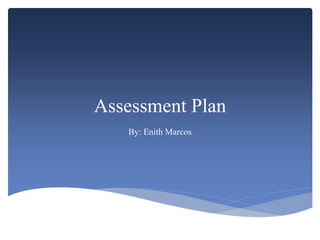
Assessment plan summary
- 1. Assessment Plan By: Enith Marcos
- 2. 1. Brainstorming: From what you already know, who do you think the Tuskegee Airmen, the 442nd Regimental Combat Team and the Navajo Code Talkers were? 2. Discussion: Did non- white men fight on behalf of the United States during World War II? Entry-Level
- 3. 1. Quiz: assessing students knowledge of the historical context in which these events are taking place. 2. Chart: 3 categories (Tuskegee Airmen, 442nd Regimental Combat Team and Navajo Code Talkers) As the unit progresses students will fill in the Who, What, When, Where, Why columns. 3. Flashcards: important names, dates, locations and achievements. 4. Ticket Out the Door: After each days lesson, students will be given a question. Students must answer this question (in complete sentences) before they are allowed to leave. Formative
- 4. 1. WWII Letters Project: Write 3 letters as if you were a Tuskegee Airmen/a member of the 442nd Regimental Combat Team or a Navajo Code Talkers explaining your experience before (1 letter) , during (1 letter) and after (1 letter) the war. 2. Display Board Presentation: Achievements of the Tuskegee Airmen, the 442nd Regimental Combat Team and Navajo Code Talkers and the impact that it had on the United States. Summative
- 5. Assessment Summary When beginning my unit, I will begin with brainstorming and a class discussion. When they brainstorm students will be able to express their ideas, preconceived notions of who the Tuskegee Airmen, the 442nd Regimental Combat Team and the Navajo Code Talkers were. By making students brainstorm, I will be able to see what students already know and what information I have to teach them. The class discussion will cover the question (Did non- white men fight on behalf of the United States during World War II?). Because of the lack of coverage that the Tuskegee Airmen, the 442nd Regimental Combat Team and the Navajo Code Talkers receive in curriculum, some students might be under the impression that only white- Americans fought during the war. This discussion will get students talking about who exactly participated in the war effort and prepare them for the unit that we are about to cover.
- 6. In order to fully understand the actions that there men made it is important for students to be aware of the historical context in which these units fought, as a result, they will be given a quiz testing their knowledge on the challenges that these men faced (such as Jim Crow laws, interment camps during the war and the actions that were taken against the Native Americans). In order to continue to monitor progress through out the unit students will have a chart that they will fill out, answering the Who (were these men?), What (challenges they faces and what did they achieve?), When (Dates?), Where (Pacific/Europe?), Why (did these men fight for a country that didn’t truly value them?). It is also important for students to be able to remember important information, such as names, dates, locations and achievements or these special fighting forces, in order to learn this information, students will be given flashcards that they will be able to study. In order to monitor every day progress students will be given a Ticket out the Door question, every time that they leave class (students will have to answer this question before they are allowed to leave, this will help reinforce important information and will also help me determine what additional the students need or what part of the lesson they didn’t understand.
- 7. For the summative assessment students will either have to complete the 3 Letter Home Project or the Display Board Presentation. For the 3 Letters Home Project students will choose one special unit fighting force (Tuskegee Airmen, the 442nd Regimental Combat Team or the Navajo Code Talkers) they will them have to write 3 letters describing their experience before, during and after the war. These letters must have historical context and information that we have learned in the unit (the chart will be useful for them to look back on important information) Once these letters are completed they will present one letter (of their choice) in front of the class. If students do not want to write 3 letters, they can choose to create a Display Board Presentation. In this display board students will have choose one special unit fighting force (Tuskegee Airmen, the 442nd Regimental Combat Team or the Navajo Code Talkers) and create a display board presentation. The display board must include multiple paragraphs, covering historical background, who they were, the struggles they faced, what they achieved and how they were treated once the war was over. Students will them present their display boards in front of the class.